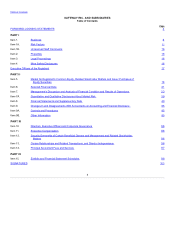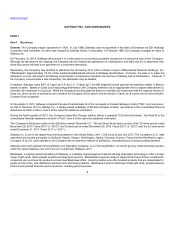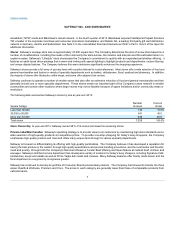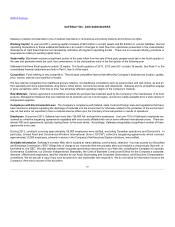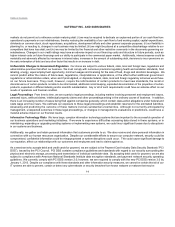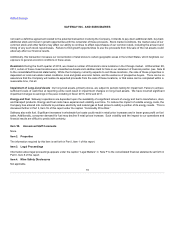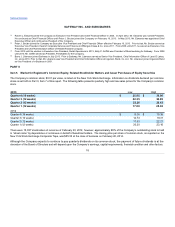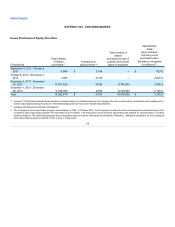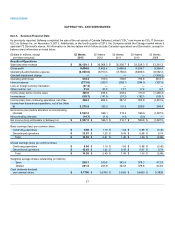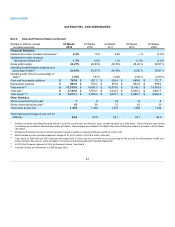Safeway 2013 Annual Report Download - page 13
Download and view the complete annual report
Please find page 13 of the 2013 Safeway annual report below. You can navigate through the pages in the report by either clicking on the pages listed below, or by using the keyword search tool below to find specific information within the annual report.
Table of Contents
New Business Initiatives and StrategiesThe introduction, implementation, success and timing of new business initiatives and
strategies, including but not limited to, initiatives to increase revenue, develop real estate or enter into new areas of business may be less
successful or may be different than anticipated, which could adversely affect our business.
Strategic Initiatives We recently announced certain strategic initiatives, including our decision to distribute the remaining 37.8 million
shares of Blackhawk common stock that we own to our stockholders and our intention to explore alternatives to monetize our investment in
Casa Ley. The timing and details of the proposed distribution of the Blackhawk shares will be determined in the near future. There also can
be no assurance whether we will be able to sell our interest in Casa Ley at a price and on terms that we find acceptable. We also recently
announced that we are in discussions concerning a possible transaction involving the sale of the Company. There can be no assurance that
these discussions will lead to an agreement or a completed transaction.
Pension and Post-Retirement Benefit Plans We maintain defined benefit retirement plans for substantially all employees not
participating in multiemployer pension plans. The funded status of these plans (the difference between the fair value of the plan assets and
the projected benefit obligation) is a significant factor in determining annual pension expense and cash contributions to fund the plans. The
decline in the financial markets during 2008 resulted in a substantial reduction in the fair value of the retirement plan assets. As a result,
cash contributions to U.S. pension and post-retirement plans increased from $7.1 million in 2010 to $151.2 million in 2011. In recent years,
cash contributions have declined due to improved market conditions and the impact of the Pension Funding Stabilization legislation, which
increased the discount rate used to determine pension funding. However, If financial markets do not continue to improve or if financial
markets decline, increased pension expense and cash contributions may have an adverse impact on our financial results.
In addition, we participate in various multiemployer pension plans for substantially all employees represented by unions. We are required to
make contributions to these plans in amounts established under collective bargaining agreements. Under the Pension Protection Act of 2006
(“PPA”), contributions in addition to those made pursuant to a collective bargaining agreement may be required in limited circumstances in
the form of a surcharge that is equal to 5% of the contributions due in the first year and 10% each year thereafter until the applicable
bargaining agreement expires. If surcharges are required, many of our bargaining agreements provide for an offset against contribution
amounts otherwise required under those agreements.
Pension expense for multiemployer pension plans is recognized as contributions are made. Benefits generally are based on a fixed amount
for each year of service. We contributed $259.2 million, $248.7 million and $238.2 million to these plans in 2013, 2012 and 2011,
respectively, excluding Canadian operations and Dominick's. Based on the most recent information available to us, a number of these
multiemployer plans are underfunded. As a result, contributions to these plans may increase. The amount of any increase or decrease in
our required contributions to these multiemployer pension plans will depend upon the outcome of collective bargaining, actions taken by
trustees who manage the plans, government regulations, the actual return on assets held in the plans and the potential payment of a
withdrawal liability if we choose to exit a market, among other factors. Additionally, the benefit levels and related issues will continue to create
collective bargaining challenges. Under current law, an employer that withdraws or partially withdraws from a multiemployer pension plan
may incur withdrawal liability, which is related to the portion of the plan's underfunding, if any, that is allocable to the withdrawing employer
under very complex actuarial and allocation rules. Multiemployer pension legislation passed in 2006, 2008, and 2010 will continue to apply
to the funds in which we participate, which may have an impact on future pension contributions.
Substantial Indebtedness We currently have, and expect to continue to have, a significant amount of debt, which could adversely affect
our financial health. As of December 28, 2013, we had approximately $4.2 billion in total consolidated debt outstanding, including capital
lease obligations. This substantial indebtedness could increase our vulnerability to general adverse economic and industry conditions. If debt
13


